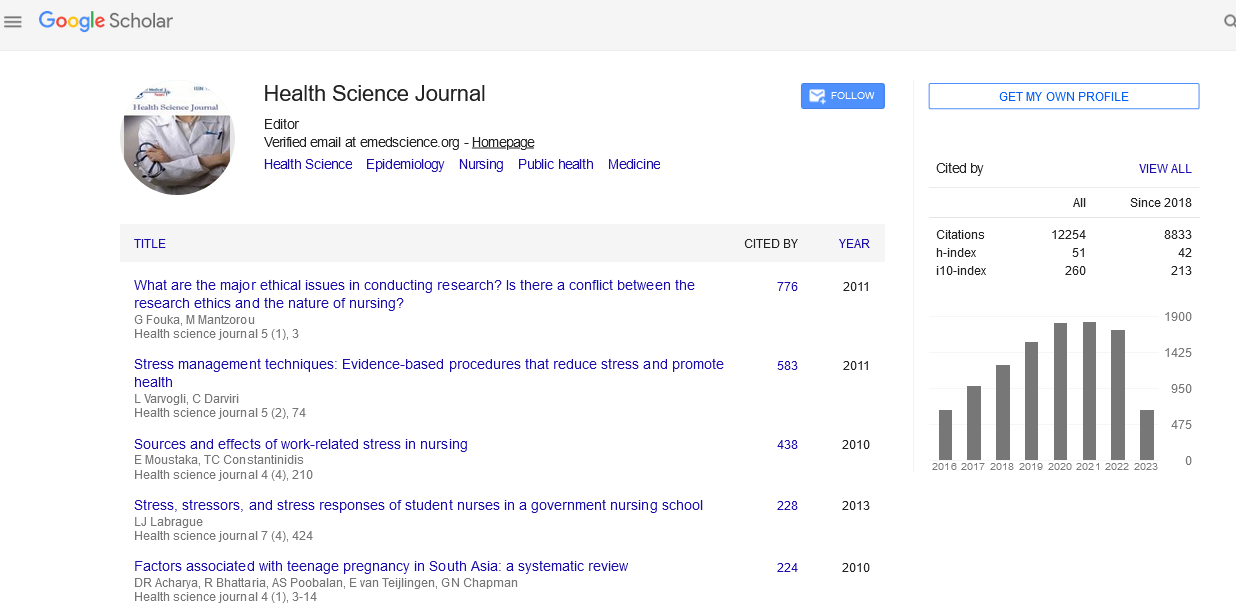Editorial - (2024) Volume 18, Issue 12
Cultural Impact on Health Literacy Among Immigrant Populations
Lianhua Ming*
Department of Health Science, University of California, USA
*Correspondence:
Lianhua Ming, Department of Health Science, University of California,
USA,
Email:
Received: 01-Dec-2024, Manuscript No. Iphsj-24-15451;
Editor assigned: 04-Dec-2024, Pre QC No. Iphsj-24-15451 (PQ);
Reviewed: 26-Dec-2024, QC No. Iphsj-24-15451;
Revised: 28-Dec-2024, Manuscript No. Iphsj-24-15451 (R);
Published:
31-Dec-2024, DOI: 10.36648/1791-809X.18.12.1212
Abstract
Health literacy is a critical determinant of health outcomes, encompassing an individual's ability to access, understand, and apply health information to make informed decisions about their health. However, health literacy is not universally distributed across populations, with immigrant groups often facing unique challenges due to cultural differences, language barriers, and varying health system experiences. This article explores the cultural impact on health literacy among immigrant populations, identifying the factors that contribute to disparities in health knowledge, health behavior, and access to care. It examines how cultural beliefs, language, education, and experiences with healthcare systems in both home and host countries shape immigrants' health literacy levels. Additionally, it discusses the implications for public health initiatives, healthcare providers, and policymakers aiming to improve health literacy in immigrant communities, and highlights the importance of culturally tailored health communication strategies.
Introduction
Health literacy plays a fundamental role in ensuring that individuals can navigate healthcare systems, manage chronic conditions, adhere to treatment plans, and make informed decisions regarding their health. However, health literacy is not a universal experience, and significant disparities exist among various population groups, particularly among immigrants [1]. Immigrant populations often encounter a unique set of challenges when it comes to health literacy, which can be influenced by a variety of cultural, linguistic, and socio-economic factors. These challenges can lead to poorer health outcomes, increased healthcare costs, and a greater burden on public health systems. Cultural influences on health literacy are profound, as different cultural beliefs, practices, and values can shape how individuals perceive health and illness, access healthcare services, and interpret health information. Furthermore, language barriers, differences in education, and unfamiliarity with the healthcare system in the host country can exacerbate health literacy challenges. Immigrant populations may also face stress related to acculturation and integration into a new society [2], which can impact their ability to navigate health systems and make optimal health decisions. This article examines the cultural dimensions of health literacy among immigrant populations, considering how cultural factors affect health behavior, knowledge acquisition, and the utilization of healthcare services. It also explores strategies that can be used to improve health literacy among immigrants and enhance their overall health outcomes [3].
Cultural Beliefs and Health Literacy
Cultural beliefs and values significantly influence an immigrant's understanding of health and illness, which in turn affects their ability to engage with health information [4]. For many immigrants, health practices and perceptions may be shaped by traditional medicine or culturally specific approaches to well-being, which can differ significantly from the biomedical models prevalent in their host country. These beliefs may inform how immigrants interpret symptoms, seek care, and adhere to medical advice. For example, in some cultures, the emphasis on holistic health and alternative treatments may lead individuals to rely more on traditional remedies rather than conventional Western medicine. Additionally, the concept of disease and treatment may vary across cultures. In some cultures, mental health issues may be stigmatized or not viewed as legitimate health concerns, while in others [5], health may be understood more in terms of balance and harmony, with a greater focus on prevention than on treatment. These differences can affect how immigrants understand health information, particularly when such information is presented within the context of the healthcare system of their host country. Moreover, cultural attitudes toward authority figures, including healthcare providers, can influence the willingness of immigrants to seek care and follow medical advice. In some cultures, there may be a high level of respect for authority figures, which could lead to a greater willingness to adhere to healthcare recommendations. In contrast, other cultures may emphasize personal autonomy or have a mistrust of the healthcare system, making it more difficult for individuals to engage with healthcare providers or follow prescribed treatments [6].
Language Barriers and Health Literacy
One of the most significant factors influencing health literacy among immigrant populations is language proficiency. Immigrants who are not fluent in the language of their host country may experience considerable difficulty in understanding health information [7], whether it is in the form of written materials, verbal instructions from healthcare providers, or informational campaigns. Misunderstandings due to language barriers can lead to poor health outcomes, as individuals may be unable to fully comprehend medical instructions, follow treatment plans, or recognize the signs and symptoms of illness. Language barriers also contribute to challenges in accessing healthcare. Immigrants who lack proficiency in the local language may be hesitant to seek care, fearing miscommunication or discrimination. Additionally, language differences can make it difficult for immigrants to navigate healthcare systems, schedule appointments, or understand insurance options. This can create a cycle where individuals avoid seeking care or delay treatment, leading to worsened health conditions and a greater reliance on emergency services or urgent care. Healthcare providers may also struggle to communicate effectively with immigrant patients, even with the use of interpreters or translation services. A lack of culturally competent care can exacerbate the challenges associated with language barriers. The use of medical jargon or an insufficient understanding of cultural contexts can make it even more difficult for immigrant patients to understand their diagnosis, treatment options, or the importance of adherence to prescribed therapies [8].
Educational Background and Health Literacy
The educational backgrounds of immigrants can also play a significant role in shaping their health literacy levels. Immigrants from countries with lower literacy rates or less-developed educational systems may struggle with understanding complex health information, regardless of language proficiency. For example, they may have difficulty interpreting health pamphlets, understanding the benefits and risks of medical procedures, or recognizing the importance of preventative care [9].
In addition, immigrants with lower levels of formal education may be less familiar with the concepts and practices of the healthcare system in their host country. The unfamiliarity with procedures such as scheduling appointments, filling prescriptions, and understanding insurance processes can create barriers to effective healthcare engagement. As a result, these individuals may be less likely to seek out preventive care, attend regular checkups, or participate in health promotion programs, which can contribute to poorer overall health outcomes.
On the other hand, immigrants with higher educational levels, particularly those who have received formal education in their host country, may have an easier time navigating the healthcare system and understanding health-related information. However, even well-educated immigrants may still encounter challenges due to cultural differences or lack of access to culturally appropriate health resources [10].
Acculturation and Health Literacy
Acculturation—the process of adapting to a new cultural environment—can also influence health literacy among immigrants. As immigrants acculturate to their host country, they may encounter challenges related to adjusting to new social norms, behaviors, and expectations. These challenges can impact health literacy, as individuals may struggle to understand new healthcare practices, navigate the healthcare system, and access available resources. For some immigrants, the acculturation process may lead to a greater adoption of the healthcare norms of their host country. However, for others, acculturation can lead to cultural dissonance, where individuals may feel disconnected from their cultural roots while simultaneously struggling to integrate into the host society. This tension can affect their ability to engage with health information and healthcare services, particularly if they perceive the health system as alien or untrustworthy. Additionally, immigrants who face discrimination or social exclusion in their host country may experience additional stress and psychological strain, which can further undermine their health literacy. Mental health challenges, such as depression or anxiety, can hinder one's ability to absorb and act on health information, exacerbating existing health disparities.
Strategies for Improving Health Literacy Among Immigrant Populations
Improving health literacy among immigrant populations requires targeted strategies that account for the unique cultural, linguistic, and socio-economic challenges these groups face. Culturally tailored health education programs are essential in bridging the gap between immigrant populations and healthcare systems. These programs should be designed to respect cultural values and traditions while providing practical, actionable health information. Additionally, increasing access to interpreters, bilingual healthcare providers, and translated health materials can help alleviate language barriers. Healthcare systems should also be trained in cultural competence, which includes understanding the cultural backgrounds, health beliefs, and practices of immigrant patients. Building trust with immigrant communities through outreach programs and community health workers can help encourage engagement with healthcare services and improve overall health literacy. Public health initiatives should also emphasize the importance of preventative care and early detection, which can be difficult to communicate to immigrant populations unfamiliar with the healthcare system. These initiatives must be accessible and delivered in culturally sensitive ways that resonate with the unique values and beliefs of immigrant groups.
Conclusion
Cultural factors significantly impact health literacy among immigrant populations, shaping how individuals access, understand, and apply health information. Language barriers, cultural beliefs about health, education, and acculturation all contribute to disparities in health literacy, which can lead to poor health outcomes and increased healthcare costs. To improve health literacy in immigrant communities, public health strategies must be culturally tailored, linguistically accessible, and designed to address the unique challenges faced by these populations. Through targeted efforts to enhance cultural competence, provide appropriate health education, and improve access to healthcare, we can foster better health outcomes for immigrants and reduce health disparities in society.
References
- Bakan P, Dibb G, Reed P (1973) Handedness and birth stress. Neuropsychologia 11: 363-366.
Indexed at, Google Scholar, Crossref
- Boumba V, Ziavrou K, Vougiouklakis T (2006) Hair as a biological indicator of drug use, drug abuse or chronic exposure to environmental toxicants. Int J Tox 25: 143-163.
Indexed at, Google Scholar, Crossref
- Cappella A, Bertoglio B, Di Maso M, Mazzarelli D, Affatato L et al.(2022) Sexual Dimorphism of Cranial Morphological Traits in an Italian Sample: A Population-Specific Logistic Regression Model for Predicting Sex. Biology 11: 1202.
Google Scholar, Crossref
- Chalathadka M, Shankar KK, Lakshmi GV, Nithin VM, Kulkarni S et al. (2019) Evaluation of Prevalence and Morphology of Dimple among Population of Sullia Taluk. J cutaneous and aesthetic surg 12: 227-230.
Indexed at, Google Scholar, Crossref
- Eglinton E, Annett M (1994) Handedness and Dyslexia: A Meta-Analysis 79: 1611-1616.
Google Scholar, Crossref
- Fontana L, Neel S, Claise JM, Ughetto S, Catilina P (2007) Osteoarthritis of the Thumb Carpometacarpal Joint in Women and Occupational Risk Factors: A Case-Control Study. J Hand Surgery 32: 459-465.
Indexed at, Google Scholar, Crossref
- Gillam L, McDonald R, Ebling FJ, Mayhew TM (2008) Human 2D (index) and 4D (ring) finger lengths and ratios: cross-sectional data on linear growth patterns, sexual dimorphism and lateral asymmetry from 4 to 60 years of age. J Anat 213: 325-335.
Indexed at, Google Scholar, Crossref
- Harris JE, Eng JJ (2006) Individuals with the dominant hand affected following stroke demonstrate less impairment than those with the no dominant hand affected. Neuro rehabilitation and neural repair 20: 380-389.
Google Scholar, Crossref
- Hitchhiker’s Thumb (Distal Hyperextensibility): Symptoms, Causes & Outlook. (n.d.). Retrieved December 8.
Google Scholar
- Inzinger M, Massone C, Arzberger E, Hofmann-Wellenhof R (2013) Hair repigmentation in melanoma. The Lancet 382: 1224.
Google Scholar, Crossref
Citation: Ming L (2024) Cultural Impact on Health Literacy among Immigrant Populations. Health Sci J. Vol. 18 No. 12: 1212.





